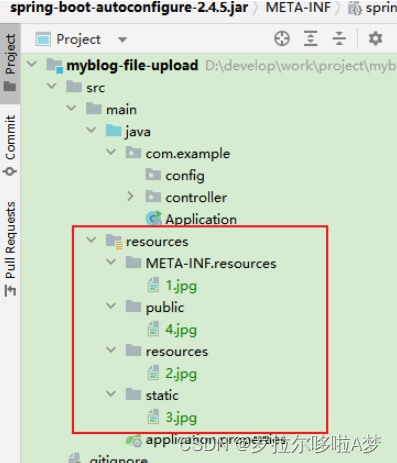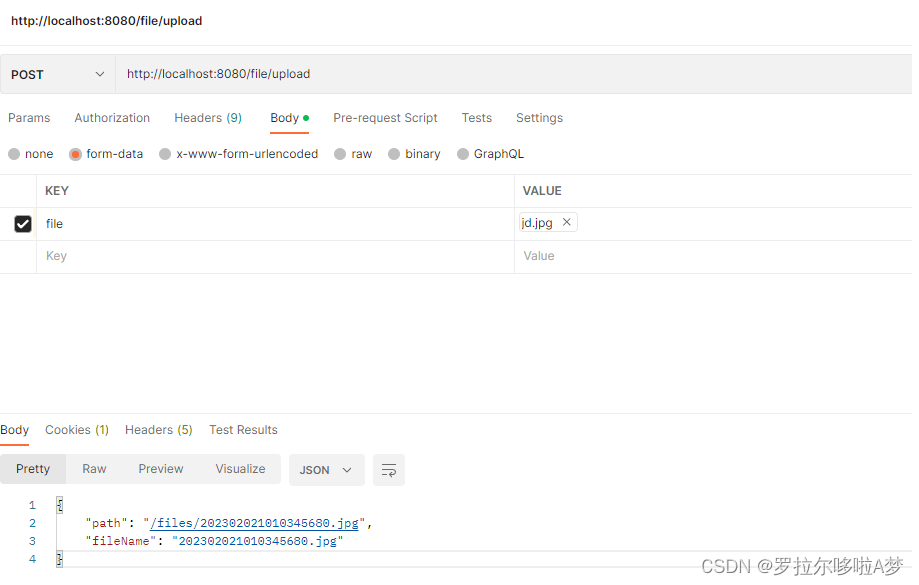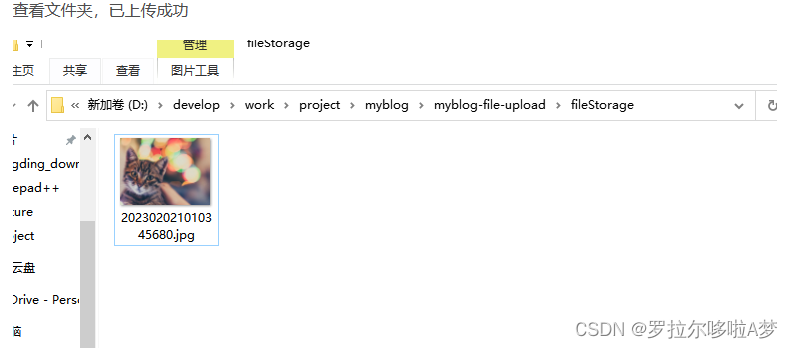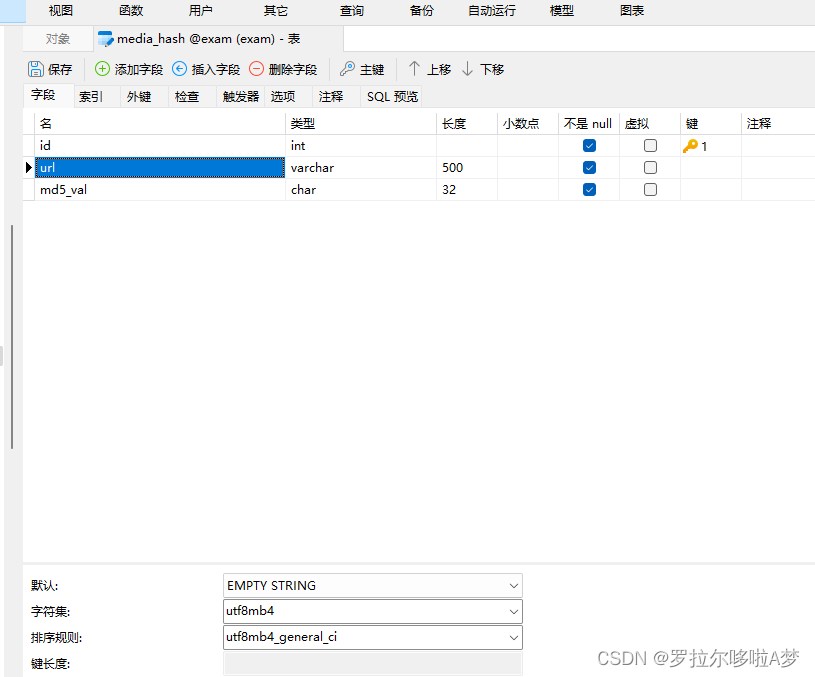SpringBoot默认静态资源访问方式
首先想到的就是可以通过SpringBoot通常访问静态资源的方式,当访问:项目根路径 + / + 静态文件名时,SpringBoot会依次去类路径下的四个静态资源目录下查找(默认配置)。

在资源文件resources目录下建立如下四个目录:

重启Spring boot,访问
http://localhost:8080/1.jpg
http://localhost:8080/2.jpg
http://localhost:8080/3.jpg
http://localhost:8080/4.jpg

上传的文件应该存储在哪?怎么访问?
1.文件存储在哪?
前文所说外部用户可通过url访问服务器资源文件resources目录下的静态资源,但若是将上传的文件都保存在resources相关目录下,将会导致后续打包过大,程序和代码不分离,无法查看等问题。
解决方案:文件上传到服务器某个目录,然后SpringBoot配置虚拟路径,映射到此目录。
2.怎么访问?
通过WebMvcConfigurer 的addResourceHandlers将匹配上虚拟路径的url映射到文件上传到服务器的目录,这样就可以通过url来获取服务器上的静态资源了。
示例代码
代码仓库github路径
目标:windows本地测试,将文件上传到 D:\develop\work\project\myblog\myblog-file-upload\fileStorage 目录下,然后通过http://localhost:8080/files/文件名 访问。
配置类
@Configuration
public class WebMvcConfig implements WebMvcConfigurer {@AutowiredFileServiceImpl fileService;@Overridepublic void addResourceHandlers(ResourceHandlerRegistry registry) {//将匹配上/files/**虚拟路径的url映射到文件上传到服务器的目录,获取静态资源registry.addResourceHandler("/" + fileService.pathPattern + "/**").addResourceLocations("file:" + fileService.filePath);WebMvcConfigurer.super.addResourceHandlers(registry);}
}
controller
@RestController
@RequestMapping("/file")
public class FileController {@Autowiredprivate FileServiceImpl fileService;@PostMapping("/upload")public FileUploadResponse upload(@RequestParam("file") MultipartFile file) {return fileService.upload(file);}
}
上传文件目录创建好后,主要通过 file.transferTo(new File(absolutePath)) 完成。
Service
@Slf4j
@Service
public class FileServiceImpl {//拦截的url,虚拟路径public String pathPattern = "files";//自己设置的目录private static final String fileDir = "fileStorage";//上传文件存放目录 = 工作目录绝对路径 + 自己设置的目录,也可以直接自己指定服务器目录//windows本地测试//绝对路径: D:\develop\work\project\myblog\myblog-file-upload\fileStorage\202302021010345680.jpg//System.getProperty("user.dir") D:\develop\work\project\myblog\myblog-file-upload//fileDir fileStorage//fileName 202302021010345680.jpgpublic String filePath = System.getProperty("user.dir") + File.separator + fileDir + File.separator;private static final AtomicInteger SUFFIX = new AtomicInteger(0);@Value(value = "${file.upload.suffix:jpg,jpeg,png,bmp,xls,xlsx,pdf}")private String fileUploadSuffix;public FileUploadResponse upload(MultipartFile file) {FileUploadResponse result = new FileUploadResponse();if (file.isEmpty()) {log.error("the file to be uploaded is empty");return result;}List<String> suffixList = Lists.newArrayList(fileUploadSuffix.split(","));try {//校验文件后缀String originalFilename = file.getOriginalFilename();String suffix = originalFilename.substring(originalFilename.lastIndexOf(".") + 1);if (!suffixList.contains(suffix)) {log.error("unsupported file format");return result;}//首次需生成目录File folder = new File(filePath);if (!folder.exists()) {folder.mkdirs();}String fileName = timeFormat(System.currentTimeMillis()) + SUFFIX.getAndIncrement() + "." + suffix;String absolutePath = filePath + fileName;log.info("absolutePath is {}", absolutePath);file.transferTo(new File(absolutePath));String separator = "/";String path = separator + pathPattern + separator + fileName;result.setPath(path);result.setFileName(fileName);} catch (Exception e) {log.error("the file upload error occurred. e ", e);}return result;}public static String timeFormat(Long time) {if (Objects.isNull(time)) {return null;}DateFormat sdf = new SimpleDateFormat("yyyyMMddHHmmssSSS");return sdf.format(time);}}测试


总结
其实这和最初的SpringBoot获取静态资源的方式又有点不一样,针对url做拦截,实际上resources目录下并没有files这个文件夹,它只是一个虚拟路径,通过映射转发到文件夹上传目录,在该目录下通过文件名去定位。
另外,如果有用nginx,也可以在其配置中设置转发。至此都是借鉴的Java实现文件上传到服务器本地,并通过url访问_java文件上传 后怎么访问-CSDN博客这位博主的内容·
后续添加补充
第一点是一个小坑,也就是System.getProperty("user.dir"),这个函数是一个 Java 中用于获取当前工作目录的方法。我本地运行出来确实是我项目的根目录,但是上到服务器,打出来的就是/,也就是linux的根目录,因此我决定以"/home/ec2-user/www/wwwroot/online_exam" 这种定值的方式取代System.getProperty("user.dir"),否则我的fileStorage目录就会建立在/这个目录下面,然后根据url访问就失效了。
第二点是我命名新文件的名字采用的是UUID的形式
第三点是我添加了一个附件表,防止重复照片的存入消耗内存,毕竟不是存在三方文件系统上,自己买的系统还是省着点,而且还可以提升一丢丢的效率。
以下是我的代码,由于是在一个github开源项目改的,所有采用的是比较老的mybatis:
pom
//下面工具类需要导入这两个依赖<dependency><groupId>com.google.guava</groupId><artifactId>guava</artifactId><version>20.0</version></dependency><dependency><groupId>commons-codec</groupId><artifactId>commons-codec</artifactId><version>1.15</version></dependency>controller
@RequestMapping("/api")
@RestController
public class CommonDataController {@Autowiredprivate FileServiceImpl fileService;@PostMapping("/upload")public ApiResult upload(@RequestParam("file") MultipartFile file){return ApiResultHandler.success(fileService.upload(file));}
}
Fileservice
package com.exam.serviceimpl;import com.exam.entity.MediaHash;
import com.exam.service.MediaHashService;
import com.exam.util.Md5Utils;
import com.exam.util.UUIDUtils;
import com.google.common.collect.Lists;
import lombok.extern.slf4j.Slf4j;
import org.springframework.beans.factory.annotation.Autowired;
import org.springframework.beans.factory.annotation.Value;
import org.springframework.stereotype.Service;
import org.springframework.web.multipart.MultipartFile;import java.io.File;
import java.io.IOException;
import java.text.DateFormat;
import java.text.SimpleDateFormat;
import java.util.List;
import java.util.Objects;@Slf4j
@Service
public class FileServiceImpl {@Autowiredprivate MediaHashService mediaHashService;//拦截的url,虚拟路径public String pathPattern = "files";//自己设置的目录private static final String fileDir = "fileStorage";public String filePath = "/home/ec2-user/www/wwwroot/online_exam" + File.separator + fileDir + File.separator;@Value(value = "${file.upload.suffix:jpg,jpeg,png,bmp,xls,xlsx,pdf}")private String fileUploadSuffix;public String upload(MultipartFile multipartFile) {try {String md5Val = Md5Utils.md5(multipartFile.getInputStream());MediaHash mediaHash = mediaHashService.findOne(md5Val);if (Objects.nonNull(mediaHash)) {return mediaHash.getUrl();}String url = uploadTo(multipartFile);MediaHash pojo = new MediaHash();pojo.setUrl(url);pojo.setMd5Val(md5Val);mediaHashService.save(pojo);return url;} catch (IOException e) {log.error("upload file error : {}", e.getMessage(), e);}return "";}public String uploadTo(MultipartFile file) {String url = null;if (file.isEmpty()) {return "the file to be uploaded is empty";}List<String> suffixList = Lists.newArrayList(fileUploadSuffix.split(","));try {//校验文件后缀String originalFilename = file.getOriginalFilename();String suffix = originalFilename.substring(originalFilename.lastIndexOf(".") + 1);if (!suffixList.contains(suffix)) {return "unsupported file format";}//首次需生成目录File folder = new File(filePath);if (!folder.exists()) {folder.mkdirs();}String fileName = timeFormat(System.currentTimeMillis()) + UUIDUtils.lowerCaseNoSeparatorUUID() + "." + suffix;String absolutePath = filePath + fileName;file.transferTo(new File(absolutePath));String separator = "/";String path = separator + pathPattern + separator + fileName;url = "http://52.25.81.116:8080" + path;} catch (Exception e) {log.error("upload file error : {}", e.getMessage(), e);}return url;}public static String timeFormat(Long time) {if (Objects.isNull(time)) {return null;}DateFormat sdf = new SimpleDateFormat("yyyyMMddHHmmssSSS");return sdf.format(time);}}
MediaHashService
package com.exam.serviceimpl;import com.exam.entity.MediaHash;
import com.exam.mapper.MediaHashMapper;
import com.exam.service.MediaHashService;
import org.springframework.beans.factory.annotation.Autowired;
import org.springframework.stereotype.Service;@Service
public class MediaHashImpl implements MediaHashService {@Autowiredprivate MediaHashMapper mapper;@Overridepublic MediaHash findOne(String md5Val) {return mapper.findOne(md5Val);}@Overridepublic boolean save(MediaHash pojo) {return mapper.save(pojo);}
}//就两个很简单的方法,一个根据md5Val查询MediaHash 对象,一个就是insert,就不贴mapper了Md5Utils
package com.exam.util;import org.apache.commons.codec.binary.Hex;import java.io.FileNotFoundException;
import java.io.IOException;
import java.io.InputStream;
import java.nio.charset.StandardCharsets;
import java.security.MessageDigest;
import java.security.NoSuchAlgorithmException;public class Md5Utils {private static final char[] HEX_DIGITS = {'0', '1', '2', '3', '4', '5', '6', '7', '8', '9', 'A', 'B', 'C', 'D', 'E', 'F'};static MessageDigest MD5 = null;static {try {MD5 = MessageDigest.getInstance("MD5");} catch (NoSuchAlgorithmException e) {e.printStackTrace();}}public static String md5(String plainText, String salt) {MD5.reset();MD5.update(plainText.getBytes(StandardCharsets.UTF_8));MD5.update(salt.getBytes());byte[] bytes = MD5.digest();int j = bytes.length;char[] str = new char[j * 2];int k = 0;for (byte b : bytes) {str[k++] = HEX_DIGITS[b >>> 4 & 0xf];str[k++] = HEX_DIGITS[b & 0xf];}return new String(str);}public static String md5(InputStream fileInputStream) {try {byte[] buffer = new byte[8192];int length;while ((length = fileInputStream.read(buffer)) != -1) {MD5.reset();MD5.update(buffer, 0, length);}return new String(Hex.encodeHex(MD5.digest()));} catch (FileNotFoundException e) {e.printStackTrace();return null;} catch (IOException e) {e.printStackTrace();return null;} finally {try {if (fileInputStream != null) {fileInputStream.close();}} catch (IOException e) {e.printStackTrace();}}}}
UUIDUtils
package com.exam.util;import java.util.Random;
import java.util.UUID;public final class UUIDUtils {public static String[] chars = new String[]{"a", "b", "c", "d", "e", "f", "g", "h", "i", "j", "k", "l", "m", "n","o", "p", "q", "r", "s", "t", "u", "v", "w", "x", "y", "z", "0", "1", "2", "3", "4", "5", "6", "7", "8","9", "A", "B", "C", "D", "E", "F", "G", "H", "I", "J", "K", "L", "M", "N", "O", "P", "Q", "R", "S", "T","U", "V", "W", "X", "Y", "Z"};private UUIDUtils() {}/*** 生成小写的uuid*/public static String lowerCaseUUID() {return UUID.randomUUID().toString().toLowerCase();}/*** 生成大写的uuid*/public static String upperCaseUUID() {return lowerCaseUUID().toUpperCase();}/*** 生成小写没有分隔符的uuid*/public static String lowerCaseNoSeparatorUUID() {return lowerCaseUUID().replace("-", "");}/*** 生成大写没有分隔符的uuid*/public static String upperCaseNoSeparatorUUID() {return lowerCaseNoSeparatorUUID().toUpperCase();}/*** 生成短uuid*/public static String shortUUID() {StringBuffer shortBuffer = new StringBuffer();String uuid = UUID.randomUUID().toString().replace("-", "");for (int i = 0; i < 8; i++) {String str = uuid.substring(i * 4, i * 4 + 4);int x = Integer.parseInt(str, 16);shortBuffer.append(chars[x % 0x3E]);}return shortBuffer.toString();}/*** 生成纯数字uuid*/public static String numUUID(int length) {Random random = new Random();StringBuilder s = new StringBuilder();for (int i = 0; i < length; i++) {s.append(random.nextInt(9));}return s.toString();}}
表结构


然后一个简单的上传接口就完成了。后续有需要可能会再次接入AWS的存储桶来进行文件存储,到时候在来继续写一篇博客


)

)
:QtWebApp用户名密码登录)





)




:树形选择排序:按照锦标赛的思想进行排序)


